
Close-up #49: Labels and serial numbers, part 1 – standard chronology
Between 1931 and 1956, the Epiphone company fitted a printed identification label to the inside back of all acoustic guitars and mandolins manufactured at their factory – visible through the bass-side f-hole (or round soundhole respectively). Starting in 1934, the internal label carried the model name and the serial number (SN) of the instrument. By 1950, the label was also introduced on electric hollowbody instruments (which didn't have an internal label before).
Epiphone changed the design of the labels several times over the years. In the respective guitar history reference books (Gruhn/Carter, Fisch/Fred) we find descriptions of the various label types. However one important question – in which years was Epiphone using which label design? – is often answered rather vaguely ... for a reason!
The changes of the label design indeed don't always appear straightforward in their chronology. While there are some obvious patterns, also rather confusing examples have shown up which don't seem to fit into any "logic" – for example: The label style typically associated with instruments from the mid-1940s and later is occasionally also spotted in guitars as early as the 1930s ...
The goal of this two-part text is to clarify some of these mysteries: This first part aims to pin down the standard chronology of Epiphone instrument labels, as they were installed in new instruments leaving the factory – pointing out some details that are often overlooked. The findings are based on our research database which includes more than 5200 instruments documented in >60'000 photos.
In part 2 we will describe some of the rather puzzling cases of label "anachronisms" and other oddities that have shown up – and we will also present our theories to explain these "phenomena".
Note: Covered by this overview are only the labels found in "Epiphone" branded guitars and mandolins from 1931 to 1956 – instruments made by Epiphone for other distributors (with brand names such as "Howard", "Sorrentino" or "Ideal") are not included at this point.
1. "Oval" label (standard 1931–34, c. SN 5300–7415)
When Epiphone introduced their new "Masterbilt" line of instruments in 1931, they applied a new serial number system starting with SN 5000. The SN was blind stamped onto the inside of the backplate, visible through the bass-side f-hole. On most of the earliest instruments there is no label inside. However around SN 5300, the stamped number starts to be consistently accompanied by an oval label: printed in black on silver paper, it featured the familiar Epiphone scroll banner logo.
Pictured below the label of SN 5431 (fragment of a guitar, likely a Melody Tenor model), with the SN blind stamped into the wood next to it.

Very early Masterbilt instruments like Broadway SN 5053 bear a stamped SN without any internal label.
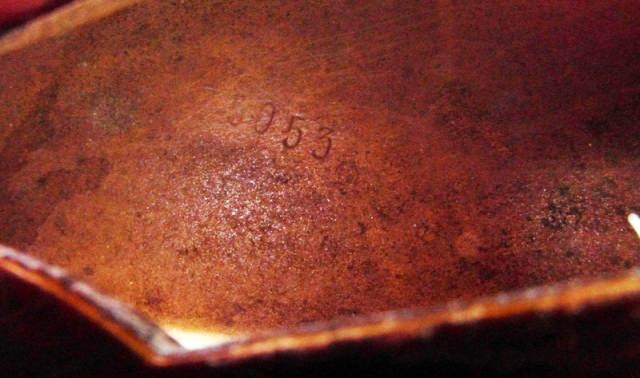
An interesting detail: By 1932, the two high-end models – DeLuxe and Broadway – started to have the SN blind stamped directly on the oval label, next to the Epiphone scroll banner logo (first documented on DeLuxe SN 6099, shown below DeLuxe SN 6254).
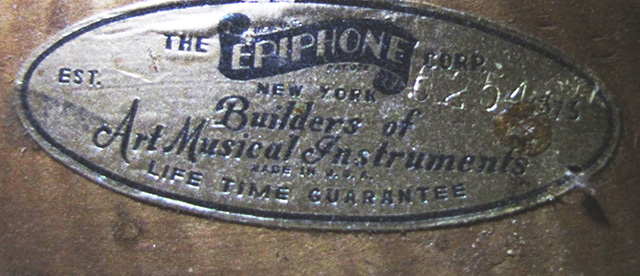
The reason for this change is not documented – but our suspicion is it may be related to the solid carved backs of these two models: Possibly this was a solution to avoid the – rather forceful – use of metal number punches on those fine wooden backs! Instead, the number got stamped on the label before it was glued to the back wood. Note that all the lower models – which had pressed laminated backs – continued to be blind stamped directly onto their (less delicate) laminated back plates.
2. "Long Island" label (standard 1934–36, c. SN 7449–10460)
When Epiphone introduced redesigned headstocks on their instruments in 1934 (now without the model name on the veneer), they also changed the label design – to a rectangular shape, printed in black on tan paper.
The new label featured two fields for model name and serial number – with dotted lines to insert this info by typewriter. There was a small Epiphone scroll banner logo and a warranty blurb with company name and location – "Epiphone Banjo Corporation, Long Island City, N.Y.". An odd detail: While Epiphone generally used the spelling "Masterbilt" for their instrument line, the label reads "Masterbuilt" ...
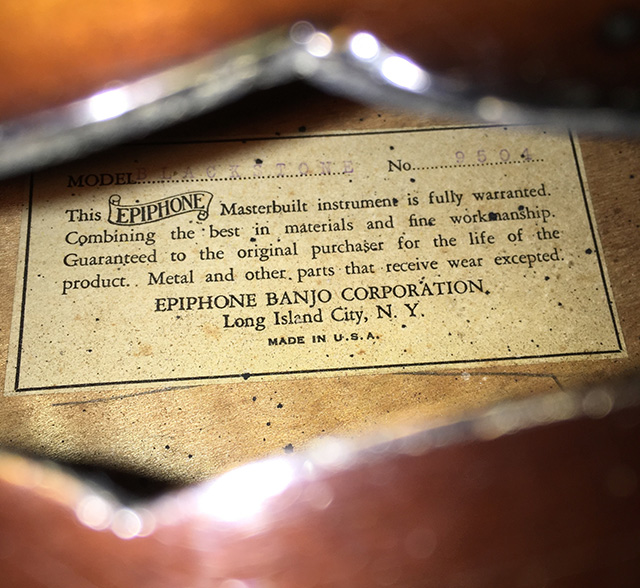
Another interesting detail: When you look closely at the picture above taken of Blackstone SN 9504, you will notice a penciled line near the lower border of the label. These slightly curved pencil markings start to show up in 1934 (Zenith SN 8364 being one of the first we know), and are consistently present until c. 1943. But what are they for?
We don't know for sure, but here our theory: The line was drawn by running a pencil along the edge of the f-hole, with the purpose to serve as a guide mark to position the label – which obviously was inserted and glued in through the f-hole after the guitar was completed! (We will come back to this detail further down the history time line.)
In 1935, Epiphone launched a new line of flattop guitars – with a low-end model initially called "FT #1" (later renamed "FT 27", referring to the price). The earliest examples of these models sport the same "Long Island" label (pictured: FT #1 SN 9155) , ...
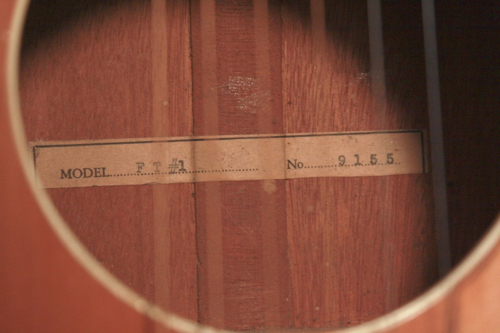
... however only the top part – cutting off the blurb and company info! We can only speculate why this was done: Maybe the humble FT #1 was not worthy of the Epiphone warranty...?
3. "Masterbilt" label (standard 1936–39, c. SN 10465–15447)
In spring 1935, Epiphone had changed the company name to "Epiphone, Inc." and relocated to Manhattan. However they kept using up the old "Long Island" labels until some time in 1936, when they introduced a new label with updated company info: While the black gothic script type on the white rectangular label had a rather "retro" look, there was an advanced feature: The SN didn't have to be typed by hand anymore, it was now pre-printed in large size on each label – probably printed by an automatic numbering device in the letterpress machine (pictured: Navarre SN 10637).

This feature was likely not only saving time, but also helped to prevent mistakes such as mistyping or duplication of a SN: Automatic numbering ensured that there was only one label for each SN produced. The model name still had to be typed by hand, of course.
Note: Although by 1936 labels with pre-printed SN became the standard in all new Epiphone (acoustic) instruments leaving the factory, there are some exceptions where the SN was still typed by hand. These "special" cases will be discussed in part 2 of this text.
4. "Green" label (standard 1939–43, c. SN 15491–20307)
The next update came in 1939 with a new rectangular label printed in green ink on white paper – sporting a fancy guilloche border and seal sign to visualize the value of Epiphone's guarantee. The labels continued to use automatically pre-printed serial numbers (pictured: FT 79 SN 18115).

This "green" label remained in use until 1943 when – after the passing of company president Epi Stathopoulo – the existing serial number system was terminated and replaced by a new scheme.
5. "Blue" label (standard 1943–56, c. SN 50000–69637)
In 1943 Orphie Stathopoulo took over as Epiphone president, and a new serial number system starting with SN 50000 was launched – with a new label to go with it: The rectangular label was printed with blue ink on white paper, still with a fancy border but without any guarantee blurb. As before it featured an automatically pre-printed serial number, and a blank field for inserting the model name by typewriter (pictured: FT
45 SN 51601).
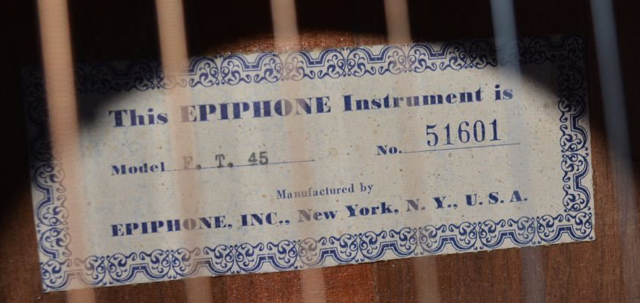
An interesting detail: Around 1945 we notice a transition of the label position in archtops – from alignment with the bass f-hole (as standard since the 1930s) to alignment with the guitar's rim; furthermore, there are no longer any penciled guide marks next to the label.
Examples below: In Ritz SN 50523 the label still aligns parallel to the narrow opening of the f-hole (pencil mark still present).

In Emperor SN 55642 the label has changed the angle and is not anymore parallel to the f-hole, i.e. now rather aligns with the guitar's rim (and no pencil mark).

The great photo below (thanks, Tony Hendrix!) nicely demonstrates this gradual "moving" of the label – on the detached backs of three Spartans, top to bottom: SN 50440, SN 55087, SN 56031.

Again, there is no "official" reason known for this – here a possible explanation: We assume that the installation procedure for the label may have changed at some point – from inserting the label through the soundhole after completion of the instrument, to gluing the label to the backplate before assembling the body.
That the latter procedure was in place in Epiphone's later years would make sense – considering another interesting, often overlooked detail seen on guitars of the mid-1950s: A second label can be found under the top of instruments – only visible with an inspection mirror/camera (or with the instrument's back taken off)! This second label features just the printed serial number – in exactly the same style as on the usual, larger "blue" label glued on the instrument's inside backplate (pictured: FT 210 DeLuxe Cutaway SN 67758, and Triumph Cutaway SN 65291).


But what are these additional SN labels about? Again, we don't know for sure – here our theory: It looks like Epiphone (at that time) had additional small SN labels printed together with the larger SN labels, using the same automatic numerating technique. These small SN labels (and the regular SN label on the back) probably served to mark/identify the separate parts before they finally got assembled to one instrument. Since the small label under the top wasn't really visible, it was just left there ...
SummaryThe table below summarizes the 5 Epiphone label types and their standard periods of use, including approximate serial number ranges:
| # | Year | Label type | SN style | SN range: first/last |
| 1 | 1931–34 | "Oval" | stamped | c. 5300 to 7415 |
| 2 | 1934–36 | "Long Island" | typed | c. 7449 to 10460 |
| 3 | 1936–39 | "Masterbilt" | printed | c. 10465 to 15447 |
| 4 | 1937–43 | "Green" | printed | c. 15491 to 20307 |
| 5 | 1943–56 | "Blue" | printed | c. 50000 to 69637 |
More about labels and serial numbers in part 2 of this text.
Note: This overview is subject to updates whenever new evidence surfaces.
(July 1, 2022)